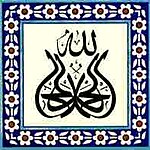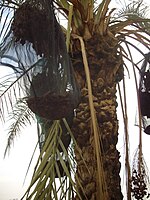List of Intangible Cultural Heritage elements in Palestine

Intangible cultural heritage (Arabic: التراث الثقافي غير المادي) are elements of the cultural heritage of the State of Palestine which are abstract and must be learned, encompassing traditional knowledge including festivals, music, performances, celebrations, handicrafts, and oral traditions.
Starting in 2008, Palestinian hikaye was the first practice from Palestine to be inscribed by UNESCO; Palestinian embroidery was inscribed in 2021. Joint inscriptions with other Arab countries for Arabic calligraphy and date palm cultivation and use were inscribed in 2021 and 2022 respectively. Four further practices have been nominated for inscription: dabkeh and Nabulsi soap-making by the State of Palestine; metal engraving, and henna, with other Arab states.
Background
In 1993, as a response to the Oslo Agreement, significant investment was made in the protection of Palestinian cultural heritage. Subsequently to this, the inscription of Palestinian cultural heritage to the UNESCO lists gives international recognition to these practices. Despite this recognition, it has been argued by researchers that the intangible cultural heritage of Palestine has struggled to survive due to Israeli occupation. As a result of the ongoing Israeli occupation, Palestine's intangible cultural heritage has been influenced by the construction of internal borders prohibiting access to land, with the resultant effect of hindering traditional agricultural practices and the semi-nomadic lifeway of some communities. Systemic cultural appropriation of Palestine's heritage has been reported, for example the appropriation of traditional Palestinian embroidery in Israeli fashion.
In some cases, Palestinian heritage was destroyed by the occupying forces: for example in the South Hebron Hills, Palestinian cave houses were confiscated by Israeli forces and the residents evicted. This disconnected young people in the area from their heritage, and in order to reconnect to their identity they collected oral histories on the cave-based lifestyle. Support for intangible cultural heritage has also been proposed as a way to foster economic and environmental sustainability, for example in the village of Battir.
For many Palestinians continued connection with their cultural heritage is a form of resistance. Palestinian henna designs have had a resurgence in popularity, with a focus on olive designs, amongst others, as an act of resistance for women.
Intangible Cultural Heritage elements
Representative List
| Name | Image | Year inscribed | No. | Description |
|---|---|---|---|---|
| Palestinian hikaye | 2008 | 00124 | A narrative form performed in Palestinian dialects, by women for women, usually during winter. | |
| Arabic calligraphy: knowledge, skills and practices + | 
|
2021 | 01718 | The artistic practice of writing Arabic letters and words to convey grace and beauty. |
| The art of embroidery in Palestine, practices, skills, knowledge and rituals | 
|
2021 | 01722 | Traditional embroidery used to decorate clothing, in particular women's. Motifs such as birds, trees and flowers are included, and designs are reflect regional identities. |
| Date palm, knowledge, skills, traditions and practices + | 
|
2022 | 01902 | There is a long history of cultivation and utilisation of the date palm in the region, which has led to the development of traditional crafts and social practises. |
| Dabkeh, traditional dance in Palestine | 
|
2023 | 01998 | A rural dance, performed by both men and women moving synchronously in a line, that has become a symbol of resistance. |
| "Arts, skills and practices associated with engraving on metals (gold, silver and copper)" + | 2023 | 01951 |
Nominations
The following practices, are pending inscription to UNESCO's inscribed list:
| Name | Image | Year nominated | Description |
|---|---|---|---|
| Henna, rituals, aesthetic and social practices + | 
|
2024 | A temporary tattooing practice with medicinal and aesthetic motivations. |
| The tradition of Nabulsi soap making | 
|
2024 | Made from olive oil, traditionally by women, this castille soap has been produced in Nablus since the fourteenth century. The industry was at its peak in the nineteenth century and went into decline in the mid-twentieth century. |
Other intangible cultural heritage
Traditional ecological knowledge (TEK) of wild plant usage in Artas has been considered as another form of intangible cultural heritage. Other forms of intangible cultural heritage that are not inscribed, or nominated for inscription, include: coffee preparation, maklouba, Palestinian architecture, Nablus cheese. Other intangible heritage beyond oral testimony from the South Hebron Hills, includes food practices of dried yoghurt and grape syrup, as well as traditional song.

